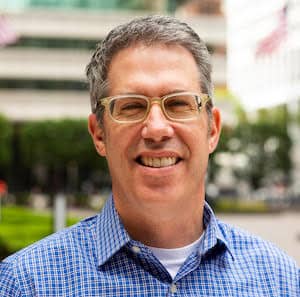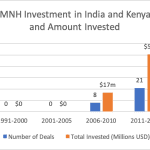Leveraging Blockchain for Good: A Q&A with Ken Weber, Head of Social Impact at Ripple
Blockchain has been sparking innovation in the social impact sector for years, and much of it has focused on digital payments – an area that presents a particularly clear use case for the technology. As Ken Weber, Ripple’s Head of Social Impact describes it, “Traditionally, the cost of moving money from one place to another has been too high, particularly in the Global South, where access to financial services for the un- and underbanked populations is limited. These populations represent the majority of people on earth, with 1.7 billion unbanked and about the same number in the ‘missing middle,’ the majority of whom do not enjoy the same access or affordable pricing for financial services we take for granted in developed economies.”
Ripple was founded in 2012 to tackle this global problem, aiming to reduce friction in payments by using blockchain and digital assets to enable financial institutions to send money across borders. To that end, the company is working with regulators, governments and central banks to implement its unique digital payment network, RippleNet.
Instead of using blockchain mining, like its counterpart Bitcoin, Ripple confirms transactions via a peer-to-peer consensus mechanism connecting a group of servers, which uses less energy, allows payments to be confirmed in seconds, and costs very little. Through this system, it aims to “enable the world to move money like information moves today” — a concept it calls the Internet of Value. The approach has gained considerable traction: Ripple is currently the third-largest cryptocurrency by market cap, after Bitcoin and Ethereum. Its global payments network now spans over 40 countries and six continents.
By streamlining and lowering the cost of payments, Ripple’s technology could make a substantial impact on underserved communities. But the company also makes an effort to expand its positive impact through its “Ripple for Good” initiatives, which encompass a wide range of goals. In the interview below, Weber discusses Ripple’s social impact efforts, which aim to advance “socially responsible and equitable uses of blockchain, cryptocurrency and related technologies.”
Katie Beasley: Your professional background is quite multifaceted. Could you shed a bit of light on your career path, as well as what led you to the digital payments space and your position as Head of Social Impact at Ripple?

Ken Weber, Ripple’s Head of Social Impact
Ken Weber: Throughout my career, I have been very fortunate to serve in roles at companies that put a special emphasis on large-scale social change, innovation and the financial and human capital required to make that change happen. A recurring question in my experience working at nonprofits and corporations alike has always been, “How do we apply financial resources, top talent and new technology to address the world’s most pressing social challenges?” Finding the answer to this question – combined with my long-standing interest in platforms’ ability to reach the largest audiences and impact the most people – is what led me to Ripple.
Ripple has in its DNA all of the right ingredients to make the global financial system more inclusive and equitable. Early on, founder Chris Larsen created a culture that valued social impact. This is a stark contrast to many tech companies who often only think of CSR as an afterthought. Chris’ vision to “complete globalization for everyone” is especially compelling, as is Ripple’s mission to create and enable a global network of financial institutions that serves everyone, everywhere.
KB: Who makes up the target market for Ripple-based financial services – and how has that market expanded or evolved since Ripple’s release in 2012?
KW: Ripple today serves more than 300 financial institutions globally, many of which serve customers who have not traditionally had equal access – or any access – to financial services. By partnering with financial institutions, such as money transfers and banks, Ripple’s goal is to improve the way people can send money globally. In today’s system, the process is slow and costly — it takes several days and high foreign exchange (FX) fees to send money to a different country. Using blockchain technology and digital assets, Ripple can help our customers’ customers by making the process quicker, cheaper and more reliable. This significant growth since its founding has helped Ripple serve the hundreds of millions of people globally who send money cross-border, either via remittances or their businesses.
KB: What are some of the primary challenges of expanding blockchain-based finance in developing economies? Which markets are particularly suited for its expansion, and why?
KW: Blockchain is a new technology that requires technical infrastructure and businesses with the technical capabilities to build and maintain systems; these elements are often in short supply in poorer countries.
On the other hand, blockchain is in some ways a “leapfrog” technology, as was mobile technology when it was introduced. Markets with high levels of economic activity and liquidity – where there is a heavy flow of payments into and/or out of the country, and where there is support for using blockchain among government, central banks and financial institutions – are among the most likely to be early adopters of this transformative technology. With this in mind, there is an obvious opportunity for entire regions, like Southeast Asia and Africa, to quickly catch up by embracing blockchain in their overall approach to economic development.
KB: Describe Ripple for Good’s approach, how it aligns with Ripple’s broader mission, and what you hope to accomplish through the program.
KW: Ripple for Good encompasses a wide range of social impact initiatives at Ripple, from engaging our employees in giving, volunteering and purpose-driven work, to Ripple’s University Blockchain Research Initiative (UBRI). Thematically, we have prioritized global financial inclusion, blockchain and fintech education, and uses cases of blockchain and digital assets for good.
In terms of financial inclusion, our goal is nothing less than to make the global financial system more accessible and affordable for hundreds of millions of people. Of course, we won’t do this alone; there are a number of innovative NGOs, social entrepreneurs and other companies we’ll learn from and collaborate with along the way. In education, we are thrilled to support the new curriculum, research and technical innovation in blockchain, digital assets and related technologies at top universities worldwide. Our shared objective with our university partners is to help create a talented and diverse, multi-sector workforce to scale and sustain the global blockchain ecosystem. From a blockchain-for-good standpoint, we are committed to ensuring that illicit uses of blockchain and cryptocurrency are limited or eliminated —and good uses of blockchain are prevalent and widespread.
KB: What are some of Ripple for Good’s biggest projects and accomplishments to date, and what does 2020 have in store for the initiative?
KW: Ripple has committed more than $100 million toward social impact initiatives to date. We have contributed to a range of global and local organizations working to expand financial inclusion, including GiveDirectly, Blockchain Charity Foundation and Tipping Point in San Francisco. We are also actively supporting a number of organizations focused on uses of blockchain for social and environmental impact, including Thorn and Global Witness.
Ripple’s university partnerships program, UBRI, is a $50 million commitment that now includes more than 35 university partners globally. Funding given to university partners for research and technical innovation in blockchain and related fields is entirely philanthropic; Ripple is not sponsoring proprietary research, and actively collaborates with faculty and students to provide strategic technical guidance and resources, as needed.
Ripple is also actively engaged in projects with a number of NGOs focused on global financial inclusion.
KB: Speaking of the University Blockchain Research Initiative, how does investment in higher education further Ripple’s social impact aims, particularly in developing markets?
KW: While blockchain and cryptocurrency have the potential to be transformative, the technology is still nascent. Academic institutions are one of the many key players that can help drive this innovation forward — similar to what academia did for the internet. Given the high level of interest on the social impact of technology across campuses and students, universities will also be instrumental in researching and uncovering new, positive use cases that are beneficial to society.
A number of Ripple’s university partners have programs focused on technology for good, as well as more traditional fields like financial inclusion. Among faculty and students, research and innovation using blockchain for good is happening organically. In fact, at our inaugural UBRI Connect conference in October, there were a number of presentations on projects deploying blockchain to address issues around healthcare, secure digital identity and homelessness.
Diversity in STEM programs and engaging traditionally underrepresented groups is also an important focus. Diversity doesn’t start in the workplace, it starts much earlier — including in the classroom. Ripple is particularly excited about its work with Morgan State University and other Historically Black Colleges and Universities (HBCUs) in the United States. In collaboration with Morgan State, Ripple is supporting dozens of HBCUs to help them develop new curriculum and research in blockchain and fintech.
KB: How does Ripple for Good help ensure that the organizations it supports respect the data rights of unbanked consumers in their financial inclusion efforts?
KW: This is a vital question and one that we are actively working to address with our NGO and university partners, as well as other blockchain and crypto companies with social impact programs. We have stayed away from initiatives that we feel have not adequately addressed the data rights and other individual and collective rights of end users, as well as those that do not have a long-range plan for how end users may be impacted. We are focused on partnering with mission-driven organizations with the potential to expand financial inclusion rapidly at scale. In all endeavors, we are strong advocates for clear ethical approaches – and, in some cases, guardrails – that ensure the best possible outcomes for all involved. We are also actively working with partners to develop an ethical playbook for how these technologies should be deployed, especially in less economically developed communities.
KB: Reflecting on your progress roughly one year after Ripple for Good was launched, what’s the biggest thing you wish you’d known about the challenges of launching this new initiative? What’s one thing you’d advise other initiative or enterprise leaders to do/avoid in their first year?
KW: I would say the biggest learning in the past year was understanding that transformative technologies – like blockchain – are still relatively early, so educating the field and our partners on its potential impact requires patience. There are hugely promising uses cases and solutions out there, but they will take time to implement and generate measurable impact.
My advice is always: Be opportunistic and seize upon quick wins when they materialize early on. At the same time, take your time to get it right – listen and learn, choose and collaborate with well-aligned partners, and design and build things for long-term, measurable and sustainable impact.
Katie Beasley is a communications specialist at the William Davidson Institute, NextBillion’s parent organization.
Photo credit: zhang kaiyv, via pexels.
- Categories
- Finance, Technology



